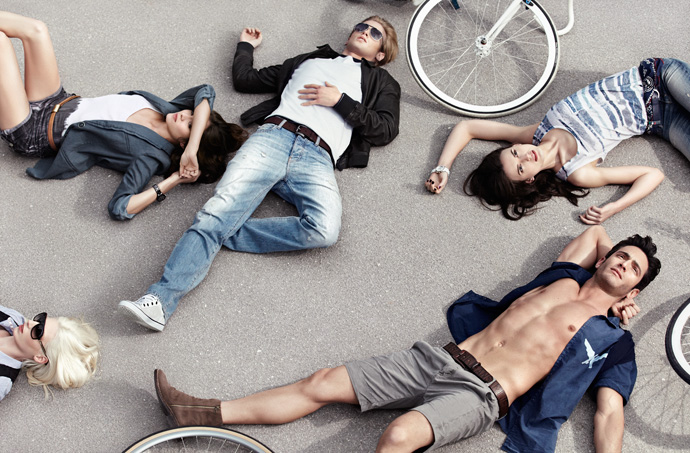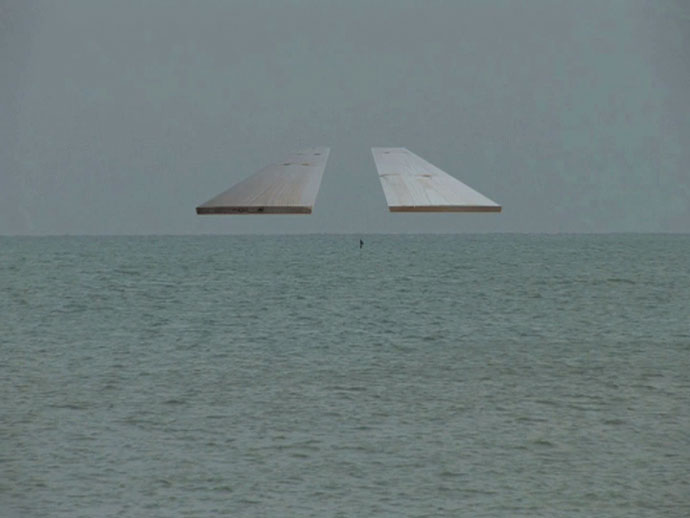-

editor MASANOBU SUGATSUKE : An edit of an edit
-Masanobu Sugatsuke is one of the most influential editors, publisher of magazines such as COMPOSITE, INVITATION or METRO MIN in his native Japan, and of books with Mark Borthwick, Elizabeth Peyton or Jeff Burton. Masa considers himself not exactly a trendy person, yet is always on a forward trail, much ahead of his time.
THE STIMULEYE talked with Masa on the outlook of publishing and the editors future role, but also his recent book EDITORIAL PARADISE in which he is looking on his past editorial work. A reflection in a radical manner, rarely dared by others of his guild.
An edit of an edit, a compilation of compilations?
He’d been advised by a fellow columnist that “When an editor enters the spotlight, he automatically announces that it is time for him to go” he was told, as well as “an expression reaches a deadlock the moment it becomes self-referential”.“But wait a minute,” he writes in his foreword, “Godard and Truffaut initiated the Nouvelle Vague with their filmic reflections on film; contemporary art has developed as a form of “Art reviewing art”, and Rei Kawakubo and Martin Margiela keep proposing dresses that inspire the wearers to think about dressing. Could it be that there exists a whole different level that self-expression can only reach after going through the painful stage of self-reference?”
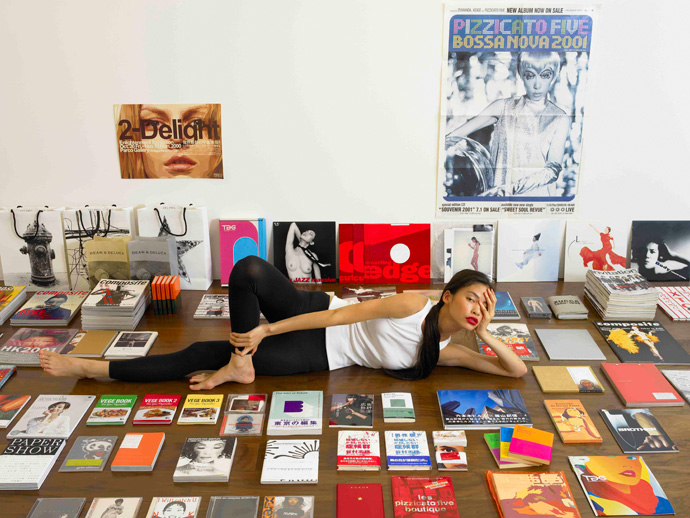 Works of Masanobu Sugatsuke laid out for EDITORIAL PARADISE.
Works of Masanobu Sugatsuke laid out for EDITORIAL PARADISE.When i visited you at you last time in Tokyo at your office – we had not seen each other for quite a long time.
Meanwhile you had halted “Composite” , and published your book “Editorial Paradise” revisiting your inventive editorial work of the last 25 years. Interestingly, this reflection coincided with a turning point, a time where the role of the editor is challenged through mechanics introduced by new media. To me it almost felt like a “katharsis” (精製) – in this context. Not only a personal one…
Talking about my book “Editorial Paradise”, I think that a retrospective book of a living editor sounds strange for everybody, even for me!
But to edit and launch it, it made me consider a lot about the role of editors and definition of editing nowadays.
I believe the role and definition of editors and editing has been drastically changing these days, because of the growing role of new media. But a few editors have been trying to define their new roles and public meaning.“katharsis” you mentioned is quite a suitable word to describe my time editing this title. Editing this retrospective is like confession for me. But confessing what?
I can tell you about it clearly now, I didn’t know the meaning of editing until that time.For this book you told me you’ve decided to include everything from the volumes that you’ve done, which is somehow “anti-editing” – was that part of making you realise the meaning of editing? What is your conclusion?
I’ve always aimed to expand the definition of editing. Through the editing process of this editorial retrospective, I recognized that the changing state of editing my thinking simple-minded.
So, what I came across through this process, – it was fun but hard for me to think deeply about editing all the time all day long and I felt like being ouroboros – is that editing is not about media.
I think editing is a way of thinking. It’s not like making film, designing a website. It’s a purely abstract idea to make something concrete.My definition of editing is quite simple.
1: Drawing up a project,
2: Recruiting a team of collaborators,
3: Creating something,They are the three basic conditions of editing, I think. If someone does something with these three conditions, whatever it is, I’d like to say “that’s editing”.
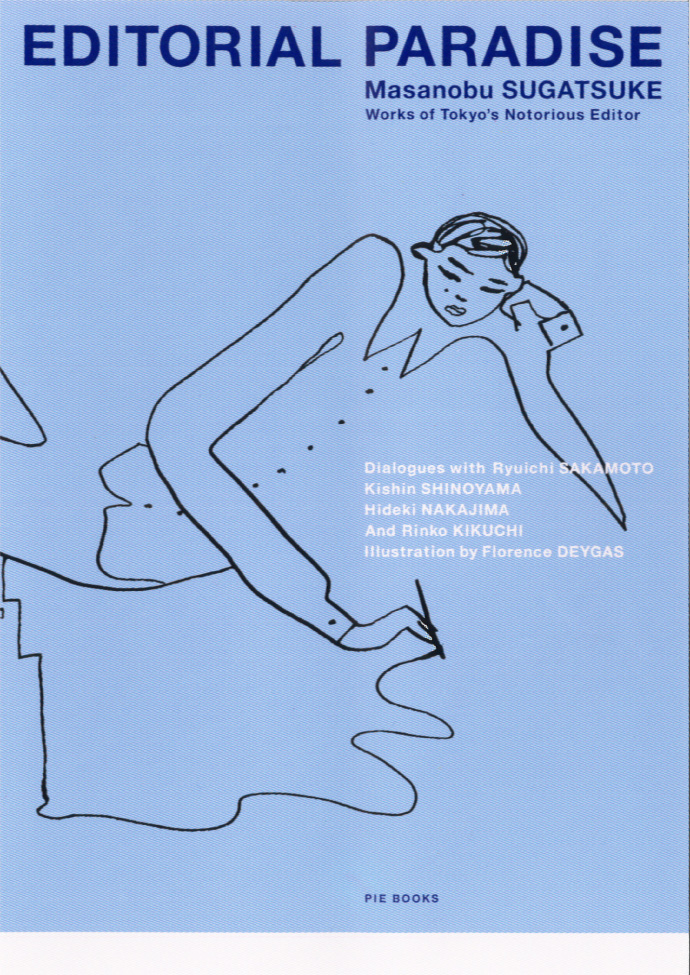
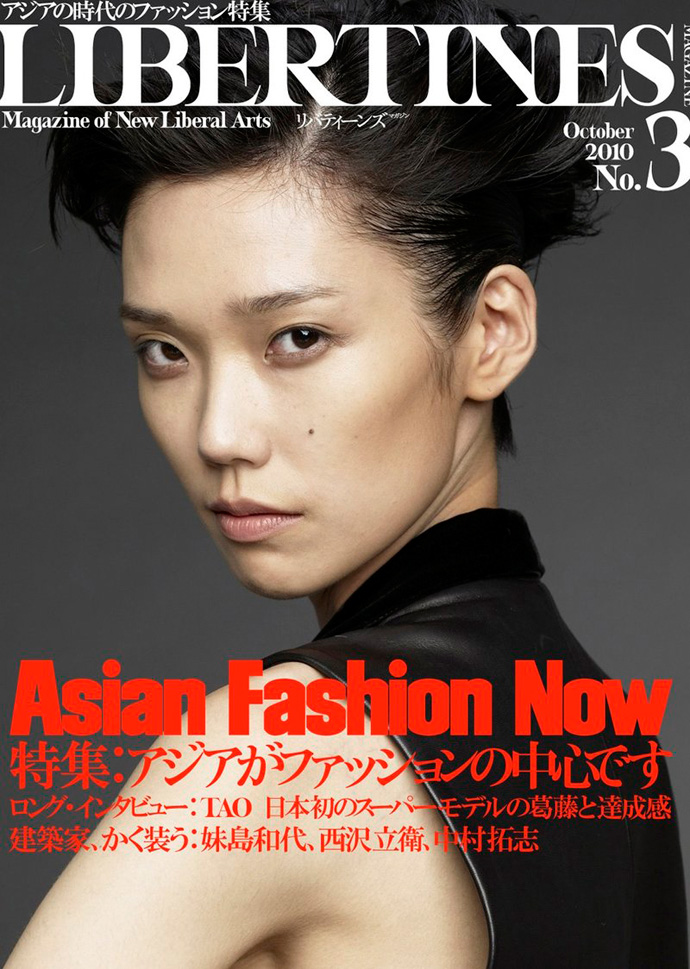 Sleeve of EDITORIAL PARADISE with an illustration of Masanobu Sugatsuke by Florence Deygas and a recent LIBERTINES cover
Sleeve of EDITORIAL PARADISE with an illustration of Masanobu Sugatsuke by Florence Deygas and a recent LIBERTINES coverIt’s something rare in this profession to put a focus on the act of editing itself, especially one’s own and in such a radical way as with your latest book.
As you can see, editors have been defined as interpreting someone to someone else, or something to something else. That means “Don’t express your own voice through your works. You are an in-between guy!”.
That’s 50% right. But there are so many high-profile advertising creative people all over the world. They are not behind the media at all nowadays.I believe editors are mainly present in-between and behind media, but sometimes they are beyond media, i.e, Anna Wintour, who is Cabinet Minister of the Ministry of Cool, Terry Jones, Everlasting Evangelist of Street Style and Olivier Zahm, the second Gainsbourg.
I believe we, creative people, have to label ourselves. In other words, we have to “transform life into creation”.
Because, in this 21st Century, our creative lives are almost viewed and leaked by web and twitter.
It’s been getting hard for creative people to avoid being watched or criticized by ordinary people now.Iconic editors from the past seem in this context like vanguards of another time to come:
Diane Vreeland (American Vogue) or, on another side of the spectrum, Hugh Heffner (Playboy), both transcended their editorial vision with their personal lives.Today’s ever more fragmented stream of information requests perhaps a stronger necessity of structure through the personal standpoint…
How do you think the element of today’s over-exposure is influencing the role of the editor?
Over-exposure is big phenomena in our world, not just for editors. Modern people are fame-addicted.
On the other hand, we can show our way of living as an art piece. Lady Gaga’s case is the most excessive one, and Haruki Murakami’s case is the most stoic.
But both are most successful presentations of life as art piece today.As I said, our creative lives are mostly viewed, watched by the media and each action are “timeline”d.
So if you can’t avoid it, you have to be determined to show your life as whole art piece, as if Andy Warhol presented us.
So, Warhol said “Everyone will be famous for 15 minutes” in the 60’s.
But now everybody became Andy Warhol, just like taking photo everyday, quoting somebody’s ideas and images and commenting as one phrase philosopher on twitter or blogs.Our creative works are slices of our creative lives. People nowadays have a tendency to prefer the real lives of creative people to their work.
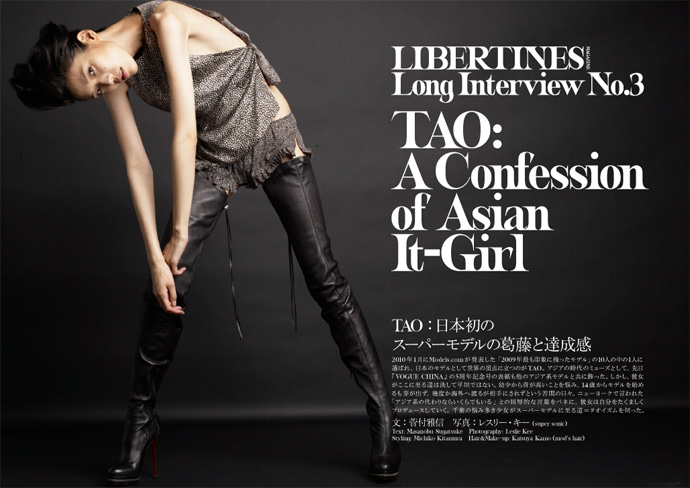 Spread of "AISIAN FASHION NOW" from a recent issue of LIBERTINES. Photo by Leslie Kee
Spread of "AISIAN FASHION NOW" from a recent issue of LIBERTINES. Photo by Leslie KeeIn these times, the stream of facebook statuses, tweets and re-tweets, tumblr and so on form a new way of consuming information.
You recently mentioned Paper.li to me – which seems like an attempt to “master” this stream almost a form of an “automatic generating editor”….Yes, “Paper.li” is a kind of semi-auto-updated personal web magazine. On the web, if you curate something, you can be an cool editor. Therefore “first hand” is getting more important for media and creative people. Audiences can’t get interviews of celebrities and take their photo first hand.
So, “first hand” sources and high profile people are the last sanctuary of professional media and creative people.
But if they are lazy to maintain “first hand” capability, audiences will rob it.The internet is certainly a big accelerator of this “theft”!
What we’re missing out besides “first hand” is the synthesis of information and its digestive analysis.
I am wondering how do you expect the print media to react to this and how you see its perspectives in the long run, in balance with the digital publishing?I expect that print media will live with digital media in symbiosis. I believe print media will survive, as opera and theatre play do.
But not mainstream in the media.
There are two kind of information, flow and stock.
Internet is a best media of flow information. Print media is a best of stock information.
For creative people, beautiful books must be great tangible assets.
In this 21st Century, tangibility and physical experience can be more important because internet cannot provide them.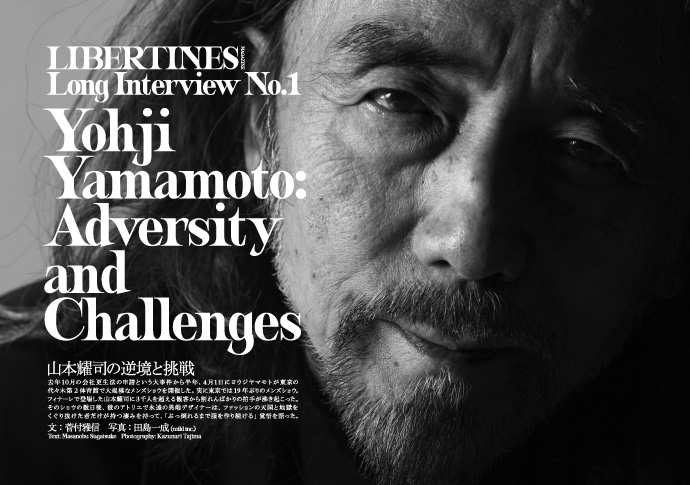 Opener of the Yohji Yamamoto Interview of LIBERTINES
Opener of the Yohji Yamamoto Interview of LIBERTINESYou have recently halted publishing your most recent print magazine “libertines”-
what was your experience with this? Were the reasons related to the shift in publishing that we’re talking about?Talking about the end of “Libertines” magazine, I think I was a little bit too optimistic about the advertising climate and today’s readers. It was my fault.
Advertising for magazine has been drastically decreasing. I knew it. But I had estimated that I could have get a certain amount of it when I started “Libertines”.
But I couldn’t. It was worst time to start a new magazine in Tokyo with a professional level of budget.Plus, I thought we could get a number of readers similar to what we had before. So, for the first issue of “Libertines”, we had a special feature about twitter culture.
We had exclusive report about twitter headquarters in San Francisco in it.
As you can imagine, we got big buzz on twitter and web when it came out.
BUT this buzz were not enough to sell magazine.It is a similar situation for musicians and the web. If some musicians get big buzz on twitter and facebook, but their record sales are not related with buzz unfortunately these days.
It happens in magazine world.I think “buying magazines” has become an old habit, or habit for people over 30’s.
If you aim to produce youth culture-medias and package contents, there are few actual youth consumers who buy them naturally.On the other hand, I’ve been directing another magazine “Metro Min.” for two years as creative director, it is quite successful because it’s a monthly free lifestyle magazine which is published by a major publisher.
So, it is hard to sell magazine to the FREE generation. I’ve been struggling with this issue.
I don’t have a clear solution for it. But I’m not pessimistic about the future of magazines. I think publishers and editors have to organize a new kind of structure to make profit not only to produce print medias.I believe there are great examples in the movie industry. The movie industry is not just about movie theatre nowadays as you know. It is an environment with movies.
I think that’s the hint for editors.

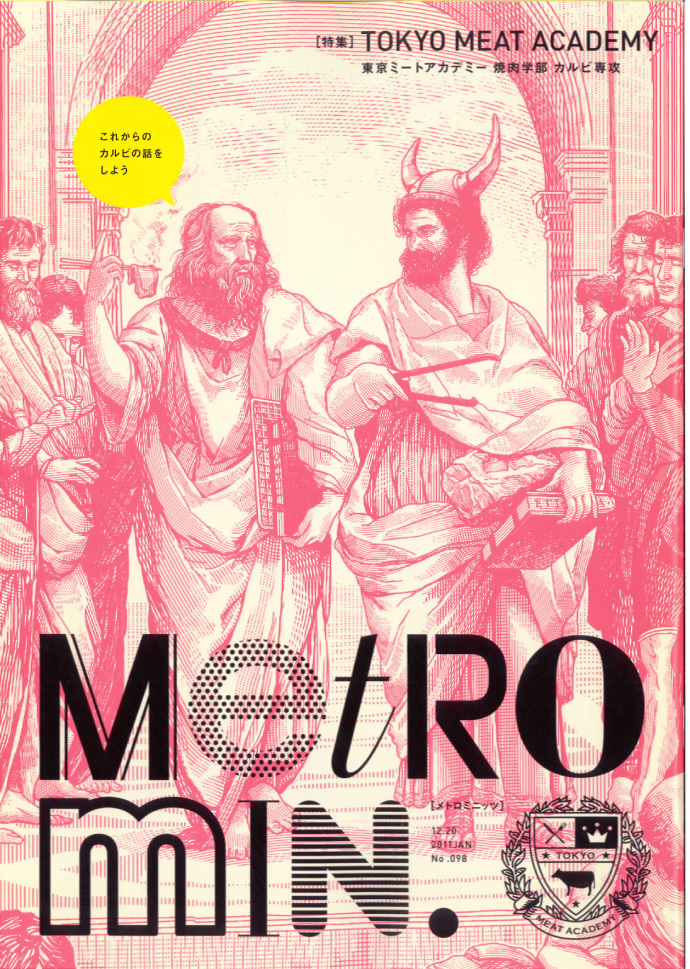 Covers of METRO MIN, the most recent publication of Masanobu Sugatsuke
Covers of METRO MIN, the most recent publication of Masanobu SugatsukeWhere do you see the future?
I’ve been thinking about the fate of both print media and new media all the time as I mentioned in our previous conversations.
And as you see, nobody knows. But there is one certain thing that I can say, that is if you love something, you’d like to own and touch it.
Same as your lover. That’s the human nature which will not change forever.People nowadays talk mainly figures and speed of modern media. But media are not only produced by them. Of course, these specs are important.
But images, sympathies, affections and favoritism are very important elements of media.
If these elements are all included in one media, then it will be a loved media no matter if it’s in the form of digital or print.I believe that creative people have to concentrate on how to produce a loved media to audiences. I think that’s the priority.
The last thing stimulated that stimulated you?
So many things and it is hard to answer to choose one particular thing.
Here is the list what I was stimulated after 3.11, the Great Earthquake in Japan.# Cindy Lauper concert in Tokyo on March 17th, just 6 days after Earthquake.
Cindy is a quite brave artist who did Japan tour in such a catastrophic situation and she commented during each break between songs to encourage audience in Japan.
She sang her masterpiece “True Colors” in encore with mix of John Lennon’s “Power to the people” and almost the whole audience, including me, wept.# Takashi Homma photo exhibition at Tokyo Opera City Gallery in April
Homma’s biggest exhibition in Tokyo which shows his conceptual landscape in Japan and Los Angels which was collaborated with Mike Mills.# Jane Birkin Charity live at Shibuya Club Quattro, April 6th
Jane Birkin is not just an actress or singer. She is a role model of modern women.# Anti-Nuclear Demonstration in Koenji, Tokyo, April 10th
Most biggest and joyful anti-nuke action in Japanese history. So many musicians joined it and I participated in it. People have the power!# Saburo Teshigawara dance performance at Kawasaki City art center, May 6th
It is a final answer to the question “How can movement of human body be radical and beautiful”. Teshigawara does European Tour this Autumn. Must-See!# Henry Darger exhibition at Laforet Museum Harajuku, Tokyo, May
Legendary outsider artist’s big retrospective. So innocent and scary.# Yohji Yamamoto’s 30th anniversary party of his brand at Y.Y boutique in Tokyo, June 1st
Yamamoto is a last samurai of cutting edgy couturier. Congratulation!
10 -

justin anderson – not another dream sequence
-At last, at last. After an epic ping pong interview months in the making, here it is. Painter – turned video artist turned – precocious fashion film director Justin Anderson.
He has a bum fetish, just like everyone else.
BIKE by Justin Anderson, for Armani Jeans. Still by René Habermacher.
Antoine Asseraf: What is the last thing that stimulated you ?
Justin Anderson: On Friday night – I watched a film by Jean Pierre Melville – ARMY OF SHADOWS.It had a big effect on me. It is brutal but very paired down without any melodrama. None of the actors either particularly young or good looking, the direction is tight and the subject really tough. It is about the French resistance to German occupation – it is about death, betrayal and torture.
The film was gripping was absolutely masterful. What I love is that I discovered this film because I loved the way Alain Delon looked in LE FLIC in his raincoat – which then led me to such a film. I feel very lucky to live in a time in which it is so easy to discover these kinds of gems and I love the fluid way you can to move from one to the other.
So, which would you say are you main influences in film-making – classic films such as the ones you just mentioned, or more experimental fare ?
All kinds of image making influence me particularly fine art – which is how I trained. I would say the paintings of Fontana, Morandi, Barnett Newman, Stella, Ryman, the sculptures of Brancusi, Donald Judd artist like Walter de Maria. Dan Graham, Bruce Nauman were particular influence to me. These have all impacted on my filmmaking as much or more so than other film makers because that is what I studied for years. I suppose my taste currently in film making are as you say classics. I was hugely influenced by Buñuel when I was introduced to it as a 14 year old boy by a very good art teacher at school – he knew exactly how to stimulate a 14 year old boy.Currently I working my way through the classic European film makers of the last century, Bergman, Antonioni, Chabrol, Renoir and recently Melville. Having not studied film I feel like I have a lot to catch up on.
UNTITLED VIDEO STILL by Justin Anderson. Courtesy of Gerwerbe Karl Marx Gallery, Berlin.
So how did you transition from fine art – painting if I’m correct – to video ?
I started working in video quite along time ago whilst still studying at the Rijksakademie in Amsterdam. The work was structuralist and minimal – I chewed gum live on television for 5 minutes, made a video in NYC where I drew the lines of a huge tennis court across midtown Manhattan and the dove them with a camera attached to the roof of a car. The video camera was moved through space like making a drawing – instead of leaving a marking on the space you were recording what is there.I made a video of a guy dressed in protective sports gear standing against a wall and shouting “Just do it” in German whilst I served tennis balls at him as hard as I could. It was quite violent (our friendship ended soon after!).
At the time I was making very large paintings of the lines on parts of sports courts- it all seemed to flow from one to another- the video camera was just another from of mark making. The videos had virtually no editing and certainly no close ups or variants in the shots.
(more…) -

1136 postcards and a smoking nun…
-One family. One postcard for every day apart. The Butlers’ uncommon journey is told by the postcards from a mother to her daughter.
Collaborating with Dutch designer Irma Boom, Jennifer Butler has published an innovative book: JAMES JENNIFER GEORGINA, a taxi yellow, 1200 pages volume in limited editions of 999 copies, parted in three sections with a joint spine, telling a unique story through 1136 postcards and 20 dialogues.
Jennifer travelled the world with her husband James, in an effort to dry him out from his alcoholism, while their daughter Georgina stayed at home with various nannies, but Jennifer sent her daughter 1 postcard per day away – 1136 postcards written from 1989 to 1999.
205 flights taken, 268,162 miles driven, 2 bullfights.
A speeding ticket.
53 unpaid parking tickets.
13 cancelled flights, 1 bomb scare, and 205 churches visited, politics, wars, rising prices, births, funerals, holidays…
Yet what comes forward above all is their relationship.
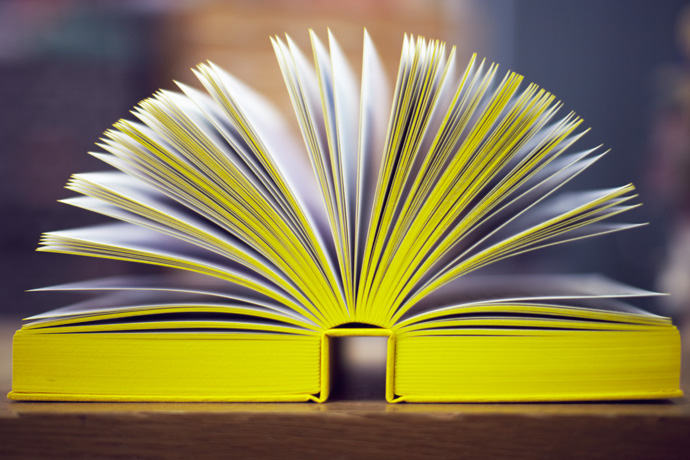 JAMES, JENNIFER, GEORGINA by Jennifer Butler. The 3 spine design allows to lay the book flat
JAMES, JENNIFER, GEORGINA by Jennifer Butler. The 3 spine design allows to lay the book flatWe meet at the American Library in Paris, 23 years after the odyssey started.
As they arrive, Jennifer, a former model, on her side her very British gentleman James, holds a copy of the book in her hands, spiked with post-its of matching yellow. She is in full swing, mentioning another book by Allen Fletcher: “Be aware of wet paint,” he wrote in his beautiful handwriting: ‘I don’t know where I am going, but I am on my way’ and it really sums me up: I don’t know ever where I am going, but I have a sense that I am gonna get there!”.
It was in fact Allen Fletcher’s work, and particularly “The Art of Looking Sideways” that made her look differently at the value of the hundreds of postcards she had kept in boxes after 10 years on the road. When in 1999 the drinking of James stopped, so did the postcards. In 2007, Allen Fletcher was only a few months more to live, so he recommended to Jennifer to work on her project with Dutch designer Irma Boom.
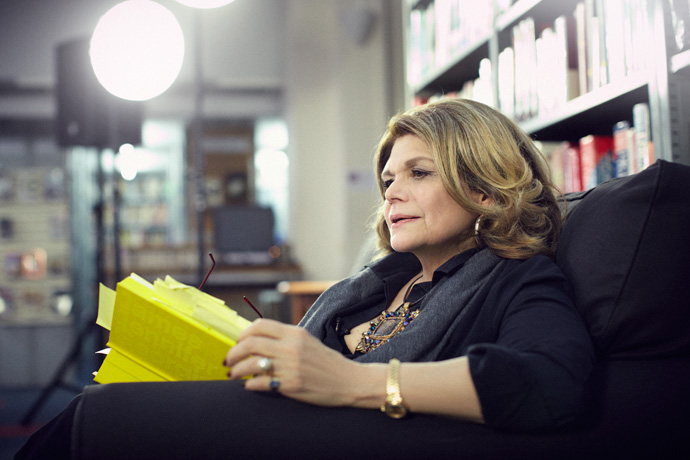 Jennifer Butler at the American Library Paris
Jennifer Butler at the American Library ParisBehind the book, says Butler, lies a passion “for extending the boundaries of what a book can be. And the knowledge that books have to be more, different than ‘information.’ More than being able to download them from the internet” she says. According to her, ‘the book’ is not in the ‘up’ – it’s in the ‘down’:
“The book remains to spread something else: maybe sheer beauty or a much slower, more thought-provoking message” Jennifer expresses in her first correspondence with Irma Boom, sharing the designer’s standpoint on book-making today.
Despite the highly sophisticated and calculated design, JAMES JENNIFER GEORGINA is an emotional matter: “The book is an extension of the content. Irma would not have designed that way for a book about tennis players, or about architecture, whatever. This book is married to the silk screen yellow that she chose, and the yellow canvas. The book is yellow because its full of light and success! […]”
“My husband, Georgina’s father, was drinking himself to death. And with one failed marriage behind me I fought to stave off a second.” James was given only two more years to live, so “to save us I took the difficult decision to leave Georgina at home. We travelled to dry James out and we travelled to shield her from the indignities of drink. Everyday we were apart I wrote to Georgina. If love waits upon a gesture, then my gesture was these postcards. I wanted her to know just who I was and just what I did. They’re a testament to a mother’s love and a sharing of advice, anecdotes, front page news and exotic places” she explains.
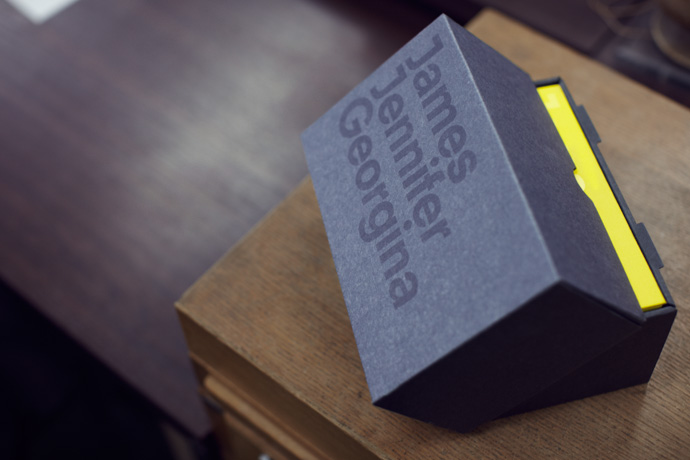 Cassette with the Book of 1200 pages, sewn in yellow cloth
Cassette with the Book of 1200 pages, sewn in yellow cloth“The post cards were never written for public consumption. They were written because I loved doing them.
And I did miss Georgina. And I did feel guilty and it was a way, felt like mothering from a distance.”
For Jennifer, it is actually a very traditional story: “there is a situation, a lot of descriptions with the postcards of a story, there is drama and there are 3 characters. They’re just divided in a very innovative way, because the description and the situation is part 1, the drama is part 2, and the characters are in an album in part 3. Usually when you read about a family or a story or a novel it’s all in one. […] ” She continues, “when people hear the word alcoholism – you know its like a dirty word or somebody survived it. The alcoholism really gave the book its Alfred Hitchcock time element.”
Jennifer admits that there was certainly a bit of irresponsibility concerning the traveling, looking back on it:
“The structure was: let’s go. Like Thelma and Louise. And I was so excited having James sober and clean shaven! He was adorable and generous and he is so knowledgeable about Europe, its history and its wars. It was like being back in university when we were driving! And there was no drink. Because he was so excited being on the road. So it really was not just about keeping him sober. He was sober and I loved the way he was.”
 Postcard from Granada, February 10, 1996
Postcard from Granada, February 10, 1996The book is framing this story of longing guilt and salvation for a wider audience in a fresh way. Despite the 210 postcards that are printed full bore in the volume, accompanied by 400 in miniature, most remarkably, the book also features a series of conversations between James, Georgina and Jennifer: “One guideline that Georgina said, and James backed her 100% up was: there would be no editing! […] “
Irma Boom, according to Jennifer, had approached the book with an enormous integrity and much love for its protagonists had insisted “that we pose the question to Georgina in one of the conversations: what was the sacrifice made by not being there. I said: ‘oh, isn’t this fantastic, Georgina spends every night looking at them.’ My mother said: ‘this is disgusting! my granddaughter is alone a third of her life!’ – of course the people who love you tell you the biggest truths.”
“It was never ever difficult [to talk about our issues as a family]. We’re all very strong characters and I think the love is so loyal that nobody worried about sacrificing love. It was never difficult to talk about the painful subjects: most of all it’s a love story.”
< (more…)
